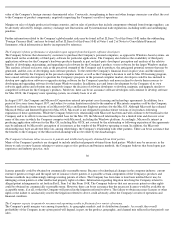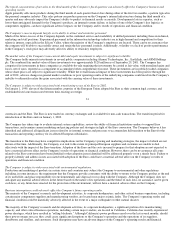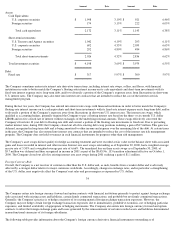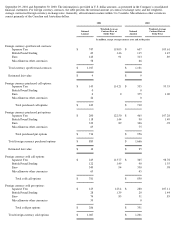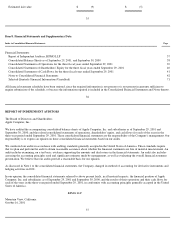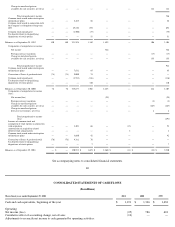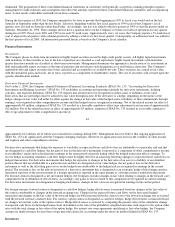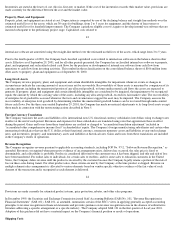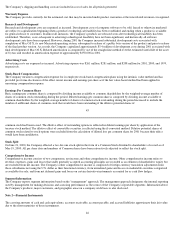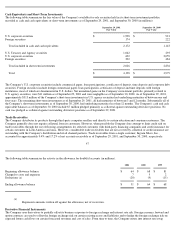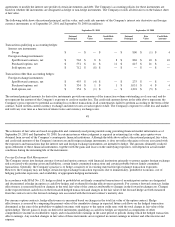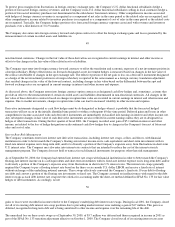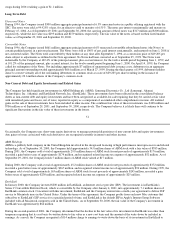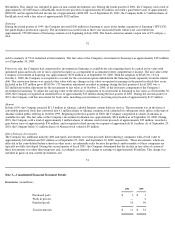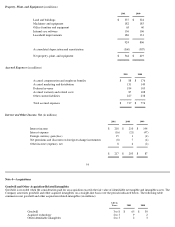Apple 2001 Annual Report Download - page 34
Download and view the complete annual report
Please find page 34 of the 2001 Apple annual report below. You can navigate through the pages in the report by either clicking on the pages listed below, or by using the keyword search tool below to find specific information within the annual report.
eliminated. The preparation of these consolidated financial statements in conformity with generally accepted accounting principles requires
management to make estimates and assumptions that affect the amounts reported in these consolidated financial statements and accompanying
notes. Actual results could differ materially from those estimates.
During the first quarter of 1999, the Company amended its by-laws to provide that beginning in 1999 its fiscal year would end on the last
Saturday in September rather than the last Friday. Likewise, beginning with the first fiscal quarter of 1999 each of the Company's fiscal
quarters now also end on Saturday rather than Friday. Accordingly, one day was added to the first quarter of 1999 so that the quarter ended on
Saturday, December 26, 1998. These changes did not have a material effect on the Company's revenue or results of operations for any quarter
during fiscal 1999. Fiscal years 2001 and 1999 were each 52-week years. Approximately every six years, the Company reports a 53-
week fiscal
year to align its fiscal quarters with calendar quarters by adding a week to its first fiscal quarter. Consequently, an additional week was added to
the first quarter of fiscal 2000. All information presented herein is based on the Company's fiscal calendar.
Financial Instruments
Investments
The Company places its short-term investments in highly liquid securities issued by high credit quality issuers. All highly liquid investments
with maturities of three months or less at the date of purchase are classified as cash equivalents; highly liquid investments with maturities
greater than three months are classified as short-term investments. Management determines the appropriate classification of its investments in
debt and marketable equity securities at the time of purchase and reevaluates such designation as of each balance sheet date. The Company's
marketable debt and equity securities have been classified and accounted for as available-for-sale. These securities are carried at fair value,
with the unrealized gains and losses, net of taxes, reported as a component of shareholders' equity. The cost of securities sold is based upon the
specific identification method.
Derivative Financial Instruments
On October 1, 2000, the Company adopted Statement of Financial Accounting Standards (SFAS) No. 133, "Accounting for Derivative
Instruments and Hedging Activities." SFAS No. 133 establishes accounting and reporting standards for derivative instruments, hedging
activities, and exposure definition. SFAS No. 133 requires that all derivatives be recognized as either assets or liabilities at fair value.
Derivatives that are not hedges must be adjusted to fair value through income. If the derivative is a hedge, depending on the nature of the
hedge, changes in fair value will either be offset against the change in fair value of the hedged assets, liabilities, or firm commitments through
earnings, or recognized in other comprehensive income until the hedged item is recognized in earnings. Net of the related income tax effect of
approximately $5 million, adoption of SFAS No. 133 resulted in a favorable cumulative-effect-type adjustment to net income of approximately
$12 million. Net of the related income tax effect of approximately $5 million, adoption of SFAS No. 133 resulted in a favorable cumulative-
effect-type adjustment to other comprehensive income of
42
approximately $12 million, all of which was reclassified to earnings during 2001. Management does not believe that ongoing application of
SFAS No. 133 will significantly alter the Company's hedging strategies. However, its application may increase the volatility of other income
and expense and other comprehensive income.
For derivative instruments that hedge the exposure to variability in expected future cash flows that are attributable to a particular risk and that
are designated as cash flow hedges, the net gain or loss on the derivative instrument is reported as a component of other comprehensive income
in stockholders' equity and reclassified into earnings in the same period or periods during which the hedged transaction affects earnings. To
receive hedge accounting treatment, cash flow hedges must be highly effective in achieving offsetting changes to expected future cash flows on
hedged transactions. For derivative instruments that hedge the exposure to changes in the fair value of an asset or a liability or an identified
portion thereof that are attributable to a particular risk and that are designated as fair value hedges, the net gain or loss on the derivative
instrument as well as the offsetting gain or loss on the hedged item attributable to the hedged risk are recognized in earnings in the current
period. The net gain or loss on the effective portion of a derivative instrument that is designated as an economic hedge of the foreign currency
translation exposure of the net investment in a foreign operation is reported in the same manner as a foreign currency translation adjustment.
For forward contracts designated as net investment hedges, the Company excludes changes in fair value relating to changes in the forward carry
component from its definition of effectiveness. Accordingly, any gains or losses related to this component are recognized in current earnings.
For derivative instruments not designated as hedging instruments, changes in fair value are recognized in earnings in the current period.
For foreign currency forward contracts designated as cash flow hedges, hedge effectiveness is measured based on changes in the fair value of
the contract attributable to changes in the forward exchange rate. Changes in the expected future cash flows on the forecasted hedged
transaction and changes in the fair value of the forward hedge are both measured from the contract rate to the forward exchange rate associated
with the forward contract's maturity date. For currency option contracts designated as cash flow hedges, hedge effectiveness is measured based
on changes in total fair value of the option contract. Hedge effectiveness is assessed by comparing the present value of the cumulative change
in expected cash flows on the hedged transactions determined as the sum of the probability-weighted outcomes with respect to the option strike
rates with the total change in fair value of the option hedge. For interest rate swap agreements qualifying as fair value hedges, the Company
assumes no ineffectiveness because these swaps meet the criteria for accounting under the short-cut method defined in SFAS No. 133.
Inventories


